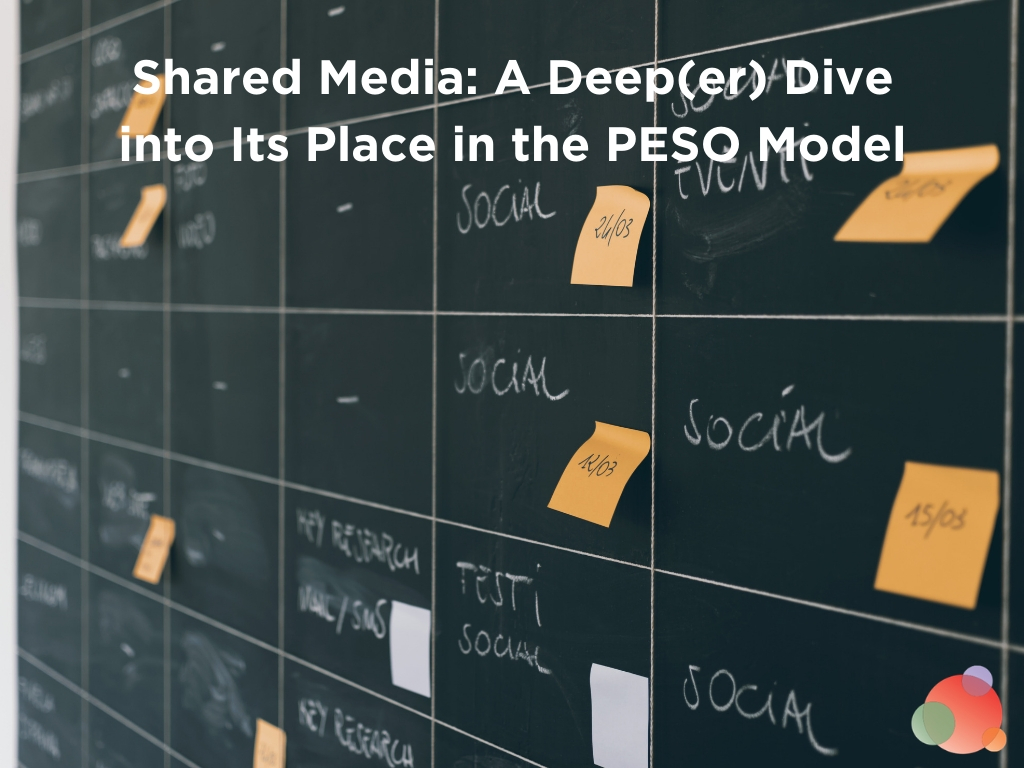 For the past couple of weeks, we’ve been doing a deep(er) dive into the PESO model.
For the past couple of weeks, we’ve been doing a deep(er) dive into the PESO model.
We worked first on paid media and then on earned media.
Now it’s time for shared media, which is not less important than the other two. It just comes next in the acronym.
But…that doesn’t necessarily mean every brand should have a presence on every account.
Not in the least.
The places you choose to engage should be relevant to your industry and to your audience.
I know you’ve seen this done badly. So why do we try to be in all places, and be all things to all people?
It just doesn’t work.
“Be All Over Social Media”
One of my favorite stories to tell is of a client that hired us and then wanted us to “be all over social media” for them.
When we asked why, the answers were versions of “because we need to be.”
We kept asking “why” and they couldn’t give us a strategic reason. So we suggested we find out where their audience was hanging out and already engaged.
For this particular client, had we to guess, we would have said LinkedIn.
But, rather than guess, they sent a survey and asked their customers.
And guess what? LinkedIn was in the second spot.
Forums around their specific industry were in the first spot—and it wasn’t something any of us had considered.
Rather than try to be all over social media or even all over LinkedIn, the first year we only worked inside the forums.
Of course, we grew it from there and we eventually got to LinkedIn and other places, but that’s not how we started.
Validate Your Channel Usage
So the first question you should ask about your shared media strategy is which social accounts you should be on.
Here are a few ways to validate if you should spend time on certain platforms:
- Search. Take your top 10 keywords and search for them on Google. Where do conversations around those topics occur? Look for the specific social media platforms where there seems to be the most discussion.
- Analyze. Log into your Analytics and look at your referral report. Which social channels send you the most traffic? If lots of people are coming FROM a particular platform, it should be on your consideration list.
- Survey. Conduct a survey and ask them to share where they get their information online and which social channels they use. This can be interesting, and you may find out something you didn’t expect about how your audiences uses social media (like we did).
- Conversation. Slip a simple question about social media channel usage into your next conversation with a client, or other audience member, and ask your customer service or success team to do the same.
Putting a little time in on the front-end making a careful decision about where you want to spend your time posting and engaging can save you a ton of time and energy down the road.
You might find out that your assumptions about which social platforms you should use were way off.
Three Questions to Validate Shared Media Messaging
Doing something like that helps you figure out where you should be socializing, and then you’re ready to go, right?
Not so fast.
Most organizations want to assign an intern to this task and let them at it.
This is a very, very bad idea. Whenever a prospect tells me they want their college kid or a young professional to handle their social media, I always respond with:
How do you socialize with your biggest customers? Is it on the golf course? Would you send your college kid or a young professional out on the golf course with your largest client without you? No? Then why would you give them the keys to your social networks without any oversight?
Social media in 2018 tends to be the first place people go before they work with an organization. Because of that, there have to be rules; standards you follow and policies that will help those running your shared media to make good, brand-saving decisions.
You probably don’t want to have to personally monitor and approve every tweet, but there should be a way that your social media team can look at a social post and quickly answer the following questions:
- Could this have repercussions?
- Does it represent our brand the way it should?
- Is this consistent with the messaging in the rest of our PESO model plan?
The answers, by the way, should be no, absolutely, and yes.
Shared Media Means Consistency Across Channels
Your shared media messaging should be informed by your company vision, your brand voice, and what you know about your audience.
If your blog is very professional and information-based, it doesn’t make sense for your Twitter feed to be an unending stream of cat videos.
(You can post two or three daily, at most. ?)
Consistency across your shared media is bolsters the rest of you strategy.
Last week we talked about how, when you are pitching content to an organization that doesn’t know you well, they’re very likely to check out your social feeds.
If what they find is at odds with what you’re pitching them, they will question whether or not you can deliver on your promise.
To stay on brand and really focus in on your target audience, it’s best to be on fewer platforms and to have some checks and balances in place.
If you do this, you’ll be really good at making connections and drive engagement, which will result in increased revenue.
Watch our FREE masterclass and learn how to implement the PESO model to achieve unparalleled communications results.
Watch PESO 2.0 Masterclass NOW
Photo by Daniele Riggi on Unsplash